
Digital innovation and insights driving customer-centric transformation: THiS Connect London 2024
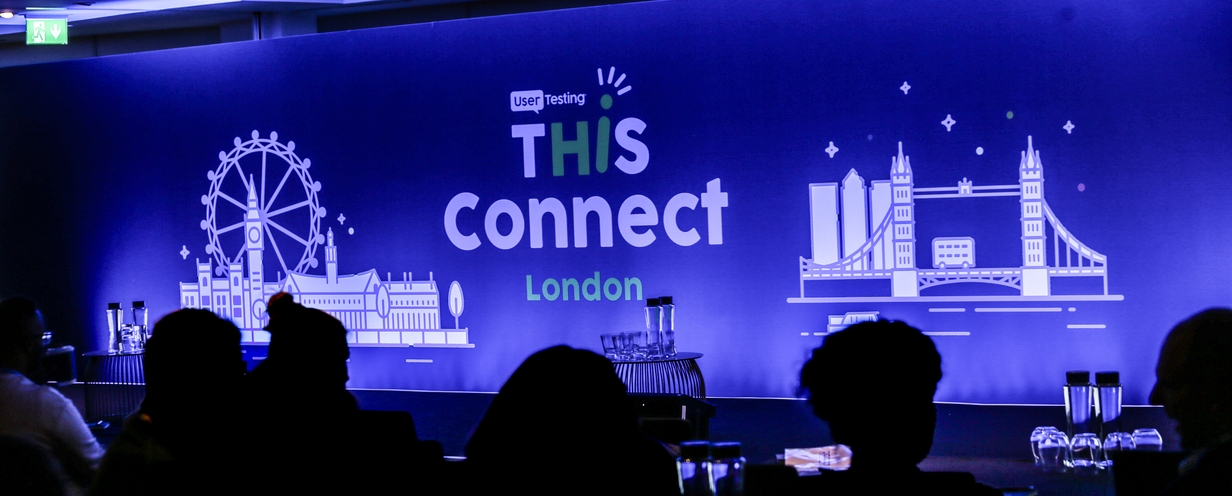
The Human Insight Summit (THiS) Connect: London 2024 was a must-attend event for digital and product leaders at the forefront of customer experience (CX) and digital transformation. Designed to empower the builders and creators shaping the future of digital products, this one-day summit offered an invaluable opportunity to dive into new strategies for bringing impactful, insight-driven innovation to life.
Through expert-led panels, practical presentations, and collaborative discussions, attendees explored ways to harness real-time customer insights and cutting-edge digital tools to push the boundaries of product excellence. If you want to understand and leverage the future of CX and digital innovation, here’s what you missed from this transformative day.
Building a culture of customer-centric digital innovation
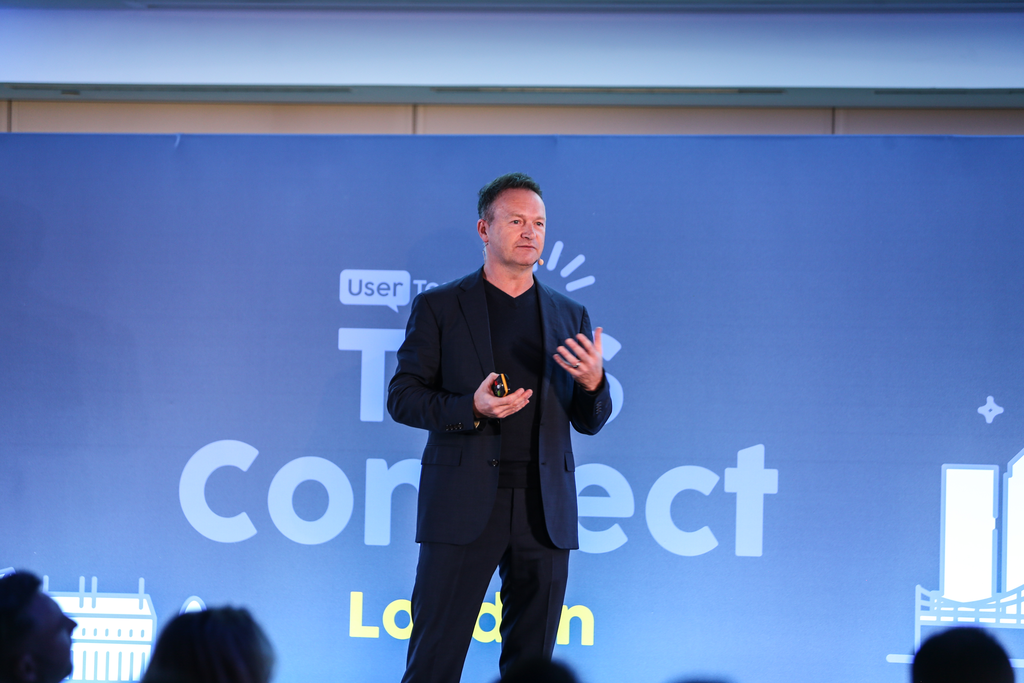
In his keynote, Jamie Anderson, UserTesting’s President of Global Field Operations, highlighted the essential connection between customer focus and innovation. Drawing on Peter Drucker’s principles, Jamie pointed out that true digital transformation stems from an organisation’s ability to understand and act on customer needs. He emphasised that customer insights should be the driving force behind digital strategies, shaping experiences that genuinely benefit users.
UserTesting’s unified platform is purpose-built to deliver faster, deeper insights, enabling teams to accelerate time-to-impact and innovate rapidly. Jamie concluded by challenging organisations to structure themselves around delivering digital products that put customers at the centre, arguing that doing so is the key to competitive advantage.
Closing the experience gap with digital transformation

Johann Wrede, UserTesting’s Chief Marketing Officer, explored the evolving experience economy by contrasting the traditional view of CX with a new, more immersive, digitally-driven approach. Using the experience gap as a framework, Johann described how companies often lose consistency in the customer journey due to fragmented handoffs between departments. He illustrated how digital tools and unified data platforms can address this gap by enabling teams to see and optimise the journey holistically.
Johann emphasised that digital innovation in CX means creating seamless, connected experiences that span the entire customer journey. He encouraged organisations to use digital platforms to identify and address breakpoints, where a lack of coordination could lead to a disjointed experience.
As he put it, “Get outside of your own process” and view each customer touchpoint as part of a cohesive journey. By embracing this broader, journey-focused approach, organisations can build frictionless experiences that inspire loyalty and brand advocacy.
Yorkshire Building Society panel: Customer-centric innovation and digital transformation in financial services

In a session featuring Mercedes Clark-Smith and Daniel Keane from Yorkshire Building Society (YBS), a UserTesting customer, the speakers shared how they’ve redefined financial services by putting customers and digital-first design at the core.
Mercedes discussed YBS’s customer duty-focused approach, supported by a digital framework that empowers teams to act quickly on customer feedback. Their model goes beyond the traditional financial services experience, delivering value through continuous digital improvements that centre on user needs.
Dan spoke to YBS’s use of the “jobs to be done” methodology to get to the heart of customer motivations, sharing how digital tools and processes have made it easier to identify and address core customer goals.
One standout example is their annual “Design Day,” a collaborative event bringing together design teams across YBS to align on customer needs and digital solutions. By democratising insights, YBS enables faster, more customer-centric decision-making, using a digitally-driven approach to deliver experiences that make a tangible difference for users.
From pixels to products: ensuring tech evolution connects with users
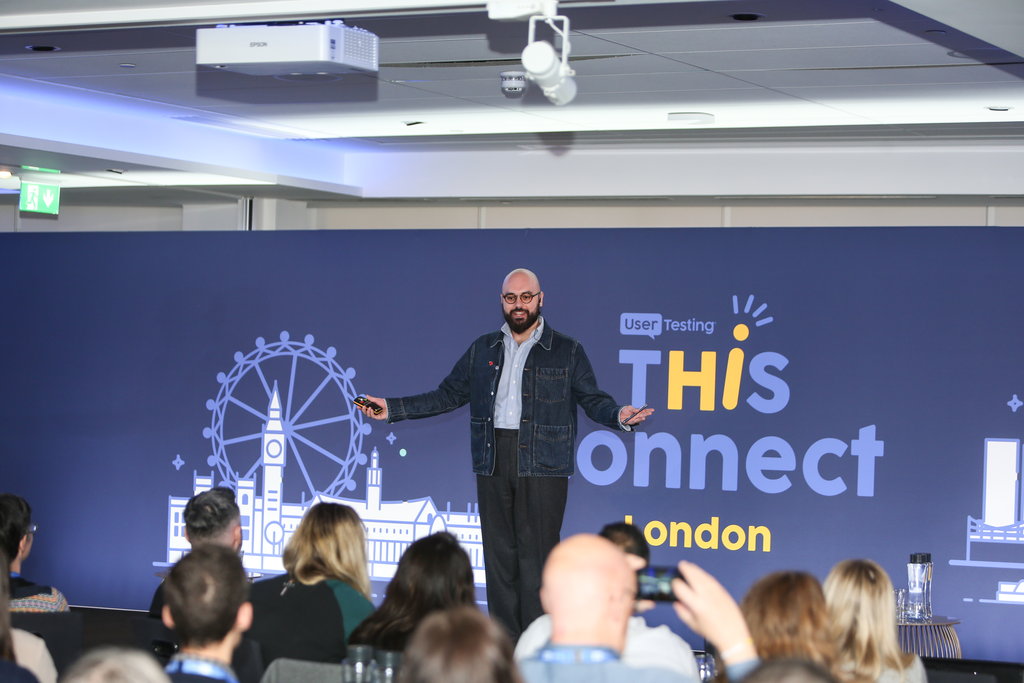
Omar Khan, a seasoned design and innovation leader with experience at Nintendo, NBC, Universal, and Sky, delivered a compelling keynote on how designers can guide users through the journey of adopting new technologies.
Using lessons from his extensive career, Omar emphasised the importance of simplicity, relatability, and keeping users at the centre of technological innovation. His talk offered practical insights into why innovations fail and how to ensure their success by addressing common pitfalls like overthinking and neglecting user emotions.
A key takeaway from Omar’s talk was the value of "lateral thinking" with technology. Using Nintendo's Game Boy as an example, he illustrated how success doesn’t always come from advanced features but rather from solving real user problems—in this case, optimising for battery life and delivering engaging games.
He also highlighted the importance of balancing data-driven decisions with design intuition, sharing an example from Sky’s redesign of the Sky Q remote. This redesign, while controversial in its simplifications, ultimately succeeded by reducing user cognitive load and enhancing the experience.
Omar closed by discussing a Sky project aimed at integrating interactive video calling with streaming content. Despite initial struggles with complex and overly technical solutions, the team ultimately succeeded by adopting a simple and intuitive design—a 9-digit code entry system.
This simplicity not only made the product more accessible but also enhanced customer satisfaction and engagement. His three key lessons—focus on technology’s practicality, avoid overthinking, and prioritise relatability—serve as a timeless guide for designing innovative yet user-friendly products.
Key panel session highlights: cross-functional digital collaboration and experimentation

In a panel moderated by Jo Hagan, Senior Solutions Consultant at UserTesting, experts from across industries—including Alan Conlan from Paddy Power, Samantha Davies from Picsart, Vanessa Barone from Vitality, and Tom Paget from Santander—discussed how digital innovation, collaboration, and experimentation can help organisations meet customer expectations faster and more effectively.
Alan emphasised the need for adaptability in digital CX strategies, explaining that customer needs and expectations are constantly evolving. Ongoing customer dialogues, facilitated by digital tools, ensure that products stay relevant and valuable.
Samantha shared how Picsart transformed their time-to-market process, leveraging cross-functional collaboration to shift from an output-based model to an outcome-focused one. This shift allows Picsart to respond more quickly to customer needs, demonstrating how digital tools and data-driven insights can accelerate innovation.
Tom highlighted the importance of democratising access to digital insights across departments at Santander, ensuring that all teams are equipped to deliver customer-first digital experiences. By embedding customer data into everyday workflows, Santander has built a company culture that keeps empathy at the forefront.
Summing up the conversation, Vanessa noted that qualitative insights bring colour to data, underscoring the necessity of blending hard metrics with real customer stories to foster empathy and drive meaningful digital change.
Empowering digital teams with human insights and AI
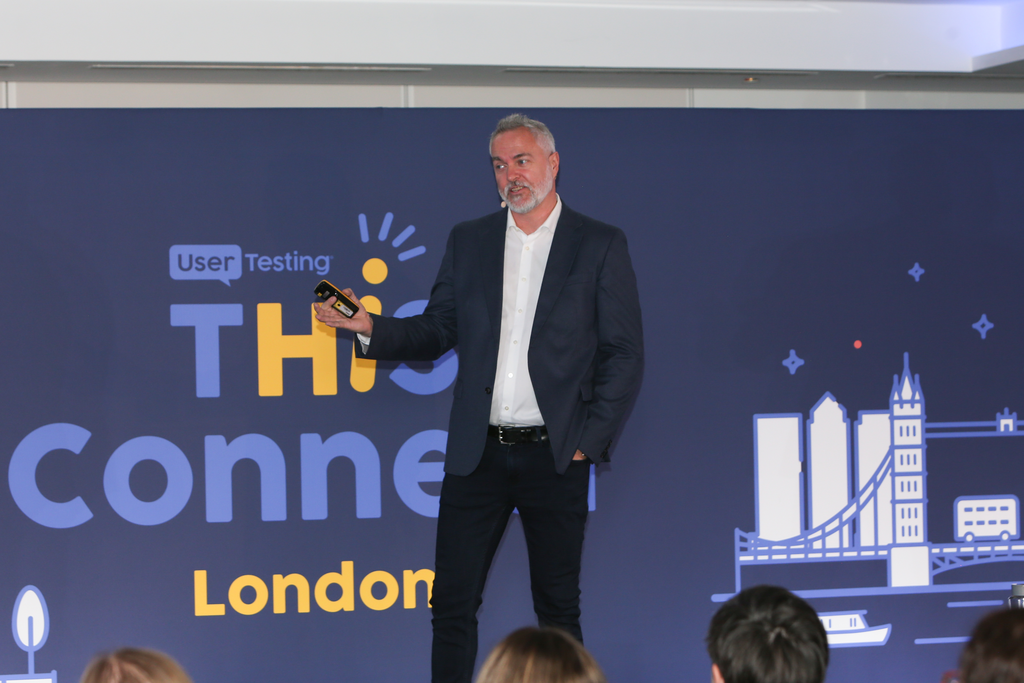
In this session, Jason Giles, UserTesting’s Vice President of Product Design, focused on UserTesting’s newest tools for empowering digital teams with real-time customer insights and intelligent automation.
With the upcoming launch of UserTesting’s all-in-one enterprise platform, Jason showcased features designed to streamline digital workflows, empower design teams, and embed customer insights into every stage of product development.
A key feature is the Insights Hub, which integrates with leading digital collaboration tools like Jira and Confluence. By embedding customer insights directly into workflows, this feature allows teams to act on feedback faster and ensures that insights are readily available across departments.
Additionally, the Design Suite includes a Figma integration, enabling design teams to catch usability issues earlier in the development process. Addressing potential problems at this stage significantly mitigates risk and rework, driving more impactful changes and empowering teams to deliver high-quality, user-centric products.
Jason also introduced QXscore™, a measurable metric for assessing CX and demonstrating impact to executives. As organisations increasingly seek proof of ROI from digital investments, QXscore provides CX and design leaders with a clear, quantifiable way to showcase the value of customer insights. This tool will play a vital role in helping teams justify CX investments and prioritise initiatives that directly contribute to customer satisfaction and business success.
How Gousto doubled productivity by redefining product discovery with AI and human insights
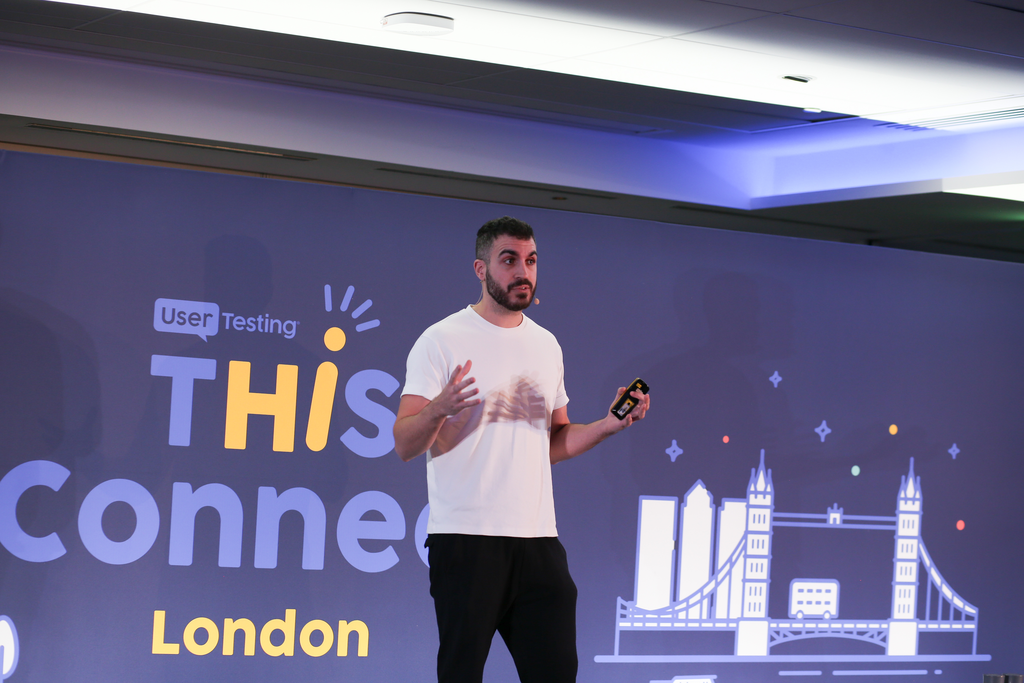
Stratis Valachis from Gousto presented an insightful session on how the company doubled productivity by redefining its product discovery process, blending AI with human insights. By focusing on divergent thinking and rapid testing, Gousto transformed its approach to innovation, enabling smarter decision-making and faster results.
The company emphasised the need to separate hypothesis testing from solution design, using lightweight, early-stage tests to validate ideas before significant investment. This approach eliminated wasted effort and allowed the team to focus on delivering meaningful customer improvements.
A significant productivity boost came from Gousto’s adoption of generative AI for internal efficiency. By applying AI to tasks like data analysis and testing, the team saved time and increased the quality of their output. The cultural shift towards embracing “learning-first design” and productivity experiments enabled Gousto to spend more time on strategic, high-impact initiatives. This mindset allowed the team to rethink their priorities, tackling larger challenges like re-architecting the app’s homepage.
The results of these changes were striking. Gousto saw increased customer satisfaction, a higher volume of winning solutions, and more impactful experiments. By fostering a culture of continuous optimisation and divergent thinking, the company unlocked new possibilities for innovation.
How Diageo used AI personalisation to deliver on innovation

Ana De La Guardia from Diageo shared how the company leveraged AI-driven personalisation to redefine consumer experiences and innovate within the beverage industry. Diageo’s approach involved blending consumer insights with cutting-edge AI tools to create deeply personalised products. A standout example was their Johnnie Walker Blue Label initiative, where customers co-created unique bottle designs through AI-powered artwork, resulting in a highly successful pilot programme.
Diageo’s innovation strategy is rooted in “future access,” a methodology that explores probable, possible, and preferable futures. This long-term vision identified key trends like neohedonism, expanded realities, and collective belonging.
By focusing on these shifts, Diageo developed products and campaigns that resonated with modern consumers. For the Johnnie Walker Blue Label project, they partnered with artist Scott Naismith to train an AI engine capable of generating bespoke designs based on individual preferences, which were then printed onto bottles.
The pilot yielded exceptional results: bottles sold out quickly, tripling monthly sales of the Blue Label line. Consumers embraced the concept, treating the personalised bottles as collectible art pieces. Ana emphasised the importance of progress over perfection, urging businesses to pilot bold ideas, learn from them, and iterate.
By fostering consumer collaboration and transparency, Diageo demonstrated that personalisation at scale is not only possible but also highly impactful. The initiative reinforced brand loyalty, increased willingness to pay premiums, and set the stage for future innovation.
Celebrating the 2024 illumi award winners
To close out the event, we celebrated the incredible achievements of our customers by announcing the winners of the prestigious illumi awards, which recognise excellence in leveraging human insights to create transformative customer experiences.
This year’s winners and distinguished luminaries represent diverse industries united by their commitment to innovation, collaboration, and customer-centricity. We’re proud to highlight achievements from the EMEA region, including:
- Bupa
- Next
- EE
- Frasers Group
- N26
- PepsiCo
- Sage
- Virgin Media O2
- Zigzag
- Yorkshire Building Society.
These awards underscore how organisations are turning insights into action, driving measurable business outcomes, and reimagining the future of customer experience. Congratulations to all the winners and nominees for their inspiring leadership and innovation!
Final takeaways: accelerating digital innovation with customer empathy and cross-functional collaboration
The key to transforming CX in today’s digital landscape is putting customers at the heart of innovation. Here are three actionable steps inspired by THiS Connect: London 2024:
- Foster cross-functional collaboration for seamless digital experiences. Customer journeys don’t adhere to departmental lines. Digital platforms that enable cross-functional collaboration can help teams break down silos, ensuring a seamless, cohesive experience at every touchpoint.
- Promote digital experimentation and incremental innovation. Incremental experimentation is a powerful way to innovate in fast-paced digital environments. Empower teams to test, iterate, and learn, using real-time insights to adapt swiftly to evolving customer needs and drive continuous improvement.
- Embed customer empathy into digital workflows with integrated insights. Use storytelling, qualitative insights, and integrated data tools to ensure every team member understands customer needs. By embedding insights into workflows, teams can make informed decisions that drive customer-centric digital experiences and foster lasting brand loyalty.
THiS Connect: London 2024 demonstrated that the future of digital excellence is rooted in customer empathy, collaboration, and real-time insights. UserTesting continues to evolve, offering advanced tools for generating and embedding insights, making the path to exceptional CX clearer and more accessible for companies worldwide.
With the right digital strategies, tools, and a commitment to understanding customers, teams can continue to push the boundaries of what customer experience and digital innovation can achieve.

Get actionable insights today
Uncover human insights that make an impact. Book a meeting with our Sales team today to learn more.





